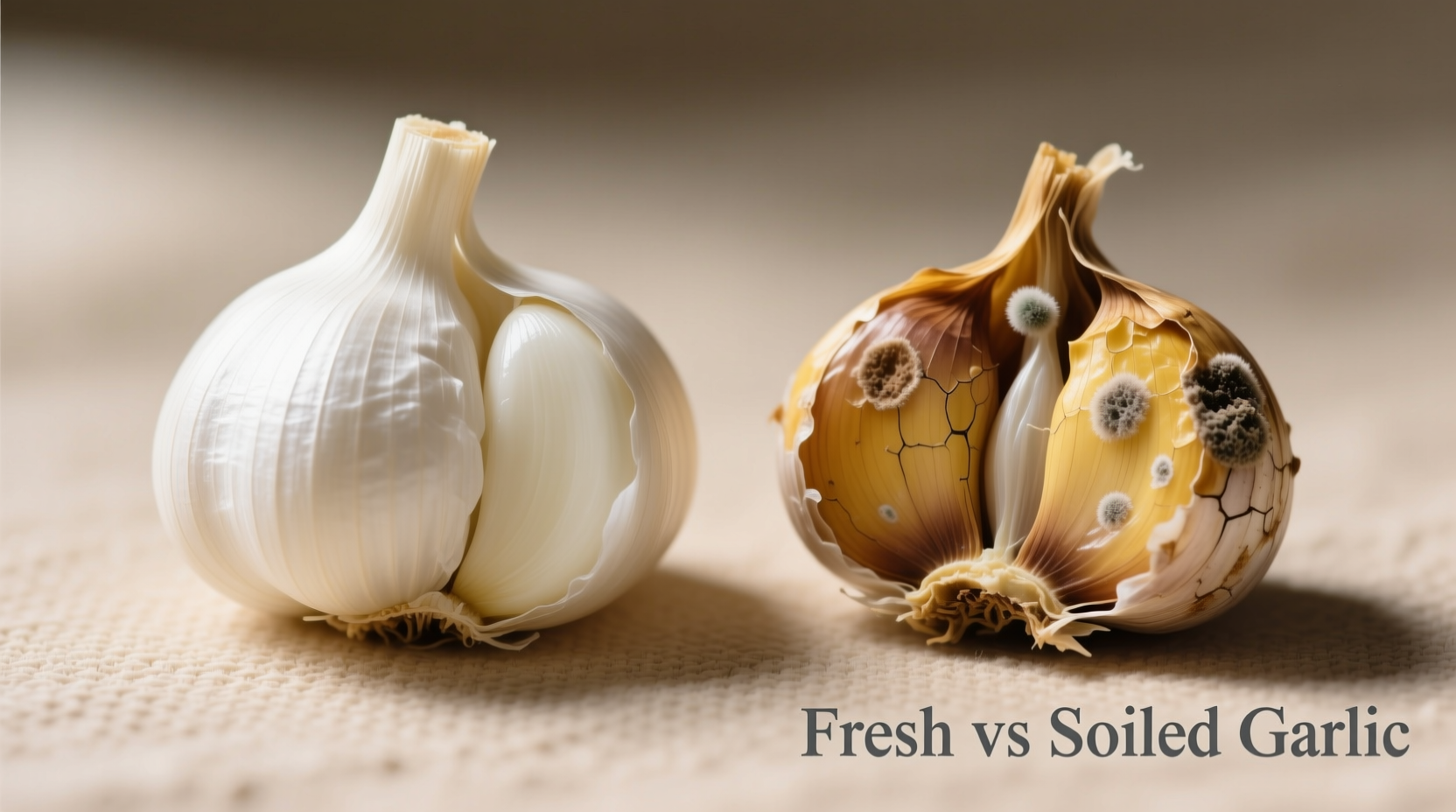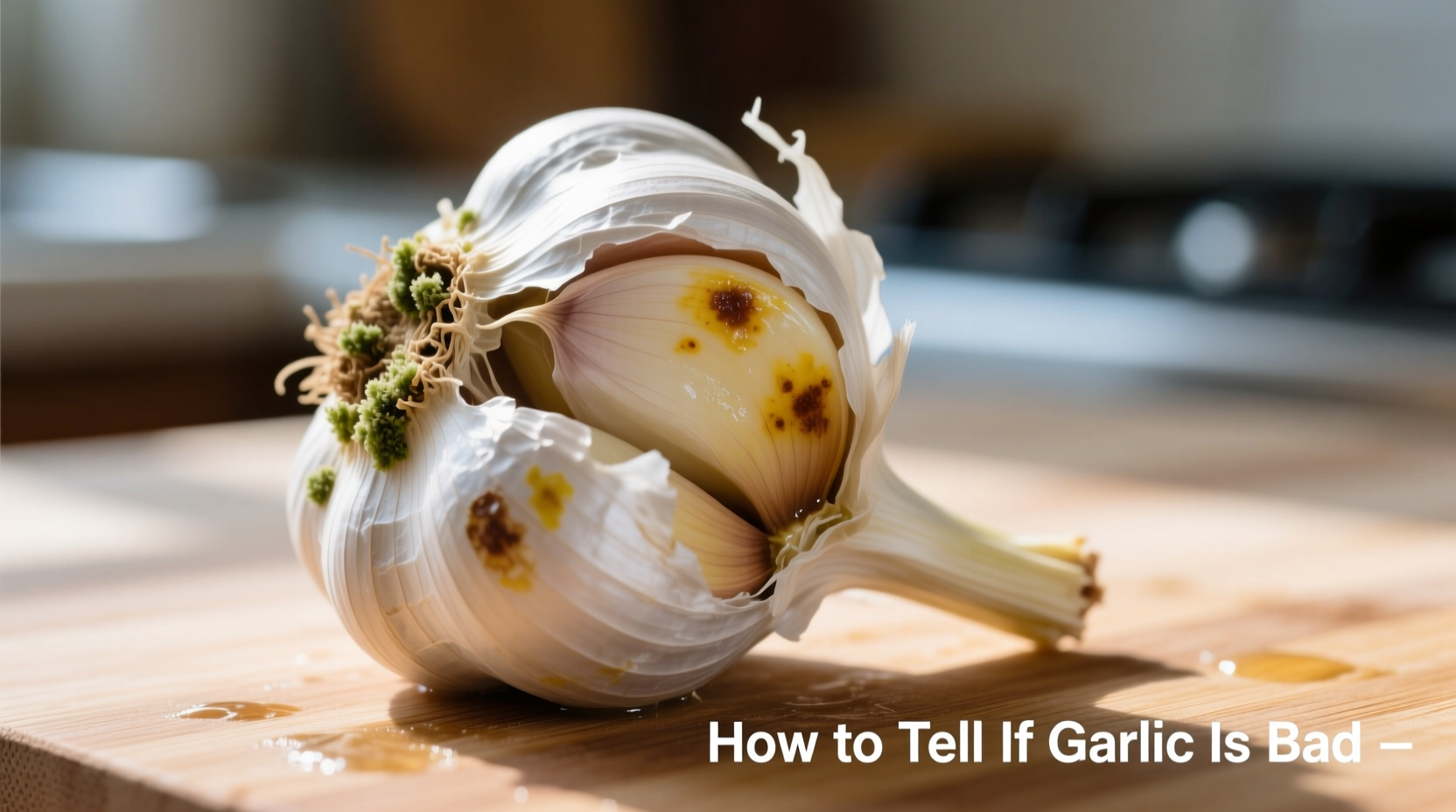Spotting Spoiled Garlic: Your Complete Visual Guide
Nothing ruins a dish faster than using spoiled garlic. As a kitchen staple that transforms simple ingredients into culinary masterpieces, garlic's freshness directly impacts your cooking results. Recognizing when garlic has gone bad isn't always obvious—especially when changes happen gradually. This guide provides clear, actionable indicators so you can confidently determine garlic quality every time.
What Bad Garlic Looks Like: The Visual Clues
Your eyes are your first defense against spoiled garlic. Proper visual inspection takes seconds but prevents ruined meals and potential food safety issues. Here's what to examine:
| Condition | Good Garlic | Bad Garlic |
|---|---|---|
| Skin Appearance | Tight, papery white skin without discoloration | Brown, yellow, or black spots; loose, peeling skin |
| Cloves | Firm, plump, uniform white color | Shriveled, discolored (yellow/brown), or soft spots |
| Sprouting | No green sprouts visible | Green sprouts longer than 2 inches emerging from center |
| Surface Texture | Dry, slightly rough texture | Visible mold (white, green, or black fuzzy growth) |
The Smell Test: When Garlic Loses Its Characteristic Aroma
Fresh garlic has a distinctive, sharp, pleasant aroma that intensifies when cut. As it spoils, this changes dramatically:
- Fresh garlic smell: Clean, sharp, slightly spicy scent
- Early spoilage: Weaker aroma than usual
- Advanced spoilage: Sour, unpleasant, or vinegary odor
- Dangerous spoilage: Musty or rotten smell indicating bacterial growth
According to USDA food safety guidelines, any sour or unpleasant odor from garlic indicates spoilage that could potentially harbor harmful bacteria. The Food and Drug Administration specifically warns that spoiled garlic can create conditions favorable for Clostridium botulinum growth when stored improperly in oil.
Texture Tells the Truth: What Your Fingers Reveal
Texture changes often happen before visible signs appear. Properly examine garlic by:
- Gently squeezing the bulb between your fingers
- Checking individual cloves after peeling
- Noting any unusual give or softness
Fresh garlic should feel solid and firm throughout. If you detect any soft spots, mushiness, or areas that indent easily under light pressure, the garlic has begun to spoil internally. The National Center for Home Food Preservation notes that garlic stored in oil at room temperature can develop botulism toxin without visible signs, which is why proper storage is critical for food safety.

Garlic Spoilage Timeline: What Happens When
Understanding how garlic deteriorates helps you catch problems early. Here's the typical progression:
- Weeks 1-4: Ideal storage conditions maintain peak quality
- Week 5-6: Sprouting begins; flavor starts weakening
- Week 7-8: Yellowing appears; cloves soften slightly
- Week 9-10: Brown spots develop; unpleasant odors emerge
- Week 11+: Significant mold growth; mushy texture; unsafe for consumption
This timeline varies based on storage conditions. The University of California Agriculture and Natural Resources states that whole garlic bulbs stored at 60-65°F with low humidity typically last 3-6 months, while refrigeration extends freshness but may cause sprouting.
When Sprouted Garlic Is Still Safe (And When It's Not)
Sprouting often causes unnecessary waste. Small green sprouts (less than 1 inch) don't automatically mean garlic is bad:
- Still usable: Garlic with small sprouts (under 1 inch) and firm cloves
- Remove sprout: Cut lengthwise and remove green shoot before use
- Discard immediately: When sprouts exceed 2 inches or cloves feel soft
The Cornell University Cooperative Extension explains that sprouting indicates aging but not necessarily spoilage. However, extensive sprouting draws moisture from cloves, accelerating deterioration and creating pathways for bacteria.
Proper Garlic Storage: Extending Freshness Safely
Preventing spoilage starts with correct storage techniques:
- Store whole bulbs in mesh bags or open containers
- Maintain cool (60-65°F), dark, dry conditions with good air circulation
- Never store garlic in sealed plastic bags or refrigerators (promotes sprouting)
- Keep away from onions which emit gases that accelerate spoilage
- Never store peeled cloves submerged in oil at room temperature
The National Center for Home Food Preservation strongly advises against storing garlic in oil at room temperature due to botulism risk. Refrigerated garlic-in-oil mixtures should be used within 7 days.
What to Do With Aging Garlic
Don't waste garlic that's beginning to age but isn't yet spoiled:
- Make garlic-infused oil (refrigerated, used within 1 week)
- Create garlic powder from slightly soft cloves
- Use in soups or stews where appearance doesn't matter
- Plant sprouted cloves to grow green garlic scapes
Remember that flavor intensity decreases as garlic ages. You may need to use more aged garlic to achieve the same flavor impact as fresh cloves.
When to Definitely Discard Garlic
Don't risk foodborne illness—discard garlic immediately if you notice:
- Any visible mold growth (white, green, or black)
- Soft, mushy texture throughout the bulb
- Sour, unpleasant, or rotten odors
- Extensive yellow or brown discoloration
- Garlic stored in oil at room temperature for more than 4 hours
The FDA Food Code specifies that potentially hazardous foods like garlic in oil must not remain in the temperature danger zone (41°F-135°F) for more than 4 hours. When in doubt, throw it out—garlic is inexpensive compared to potential foodborne illness.











 浙公网安备
33010002000092号
浙公网安备
33010002000092号 浙B2-20120091-4
浙B2-20120091-4